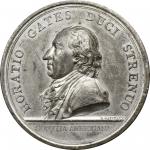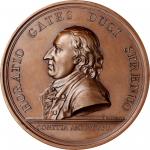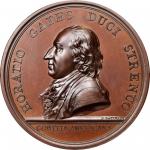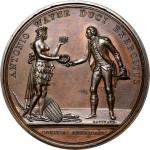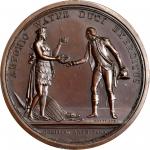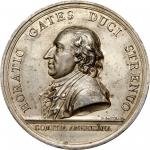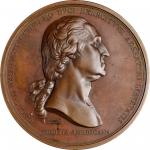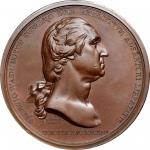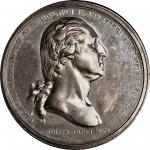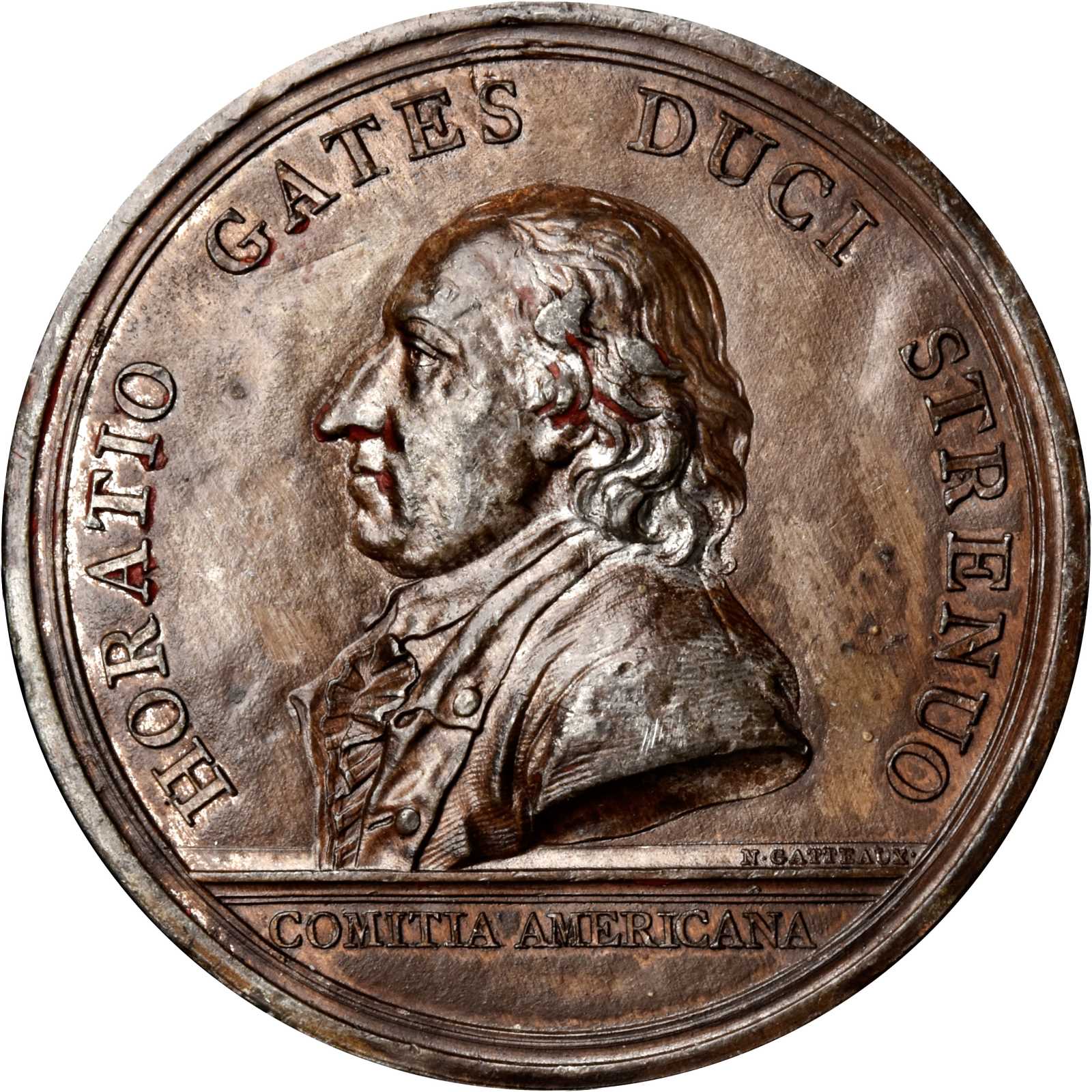1777 Horatio Gates at Saratoga obverse cliche. Betts-557. White metal. Original striking. Workshop of Nicolas-Marie Gatteaux. 54.9 x 55.0 mm, 361.0 grains. 1.5 - 2.0 mm thick. Extremely Fine.Plain irregular edge. Paper backed, with complete coverage by the thick paper, somewhat folded back at top and peeled away near right lower periphery. The die state is equivalent to that seen on the previous lot and that seen on the unique gold medal. <p>The production quality of this piece is not as fine as the previous, but splashers (also called cliches or epreuves) were not designed to be pretty or even intended to be saved. They were simply to give a positive (i.e. relief) impression of a die that was engraved in the negative (i.e. incuse). This piece shows some waviness in the fields and some irregularity at the edges that suggest a quick pour with no significant post-production preparation. The applied patina, meant to suggest a bronze tone, has left the surfaces of the reactive tin slightly granular. Red sealing wax remains in several intricacies of the portrait, legend, internal rim, exergual line, and edge; perhaps this splasher was used to impress the design into sealing wax on a letter rather than risking having to clean wax out of the steel die. The wax is ancient, original, and stable.<p>The only other Gates obverse splasher known to us is offered in the previous lot. While we know of no provenance prior to this pieces acquisition from noted American Francophile Richard Margolis, it is suggestive that the sole appearance of a lone obverse cliche of the Gates medal weve recorded comes from the too-little-known fixed price list issued in 1913 by Godefroy Mayer of Paris. Entitled "Old Paintings, Drawings, Miniatures, Statuettes, Busts, Snuff Boxes, Bonbonnieres, Medallions, Medals, and Other Objects of Art Related to America," Mayers offering was extraordinary: silver original strikes of Howard and William Washington, splashers of Gates and Morgan, a uniface Dupre Franklin medal in bronze, along with five (!) cliches of the Libertas Americana medal and a set of large plasters representing the central device of each side. Either there exists but a single unknown Gates obverse cliche in the historical record <em>and</em> this piece has no provenance prior to 2010 <em>or </em>this is the piece offered by Mayer in 1913 as lot 355. <p>This piece is a fascinating relic of the design process for this historical American medal, handcrafted by Nicolas-Marie Gatteaux in the spring of 1787.<strong>A Note On Trials: Clichés, Épreuves, and Splashers </strong><p><p>The Adams Collection of Comitia Americana and related medals is uniquely enriched by several specimens of a unique form of medallic production that is known by several different names. Typically struck from a die in its earliest state, usually before hardening, these trials were called épreuves - proofs - in the original French correspondence between Dupre and Duvivier and the Founding Fathers charged with the acquisition of the medals the Continental Congress authorized. In more modern numismatic literature, they are more often called clichés or splashers, the latter term being a fair description of just how these trials were made.<p>Unhardened dies are incredibly susceptible to damage, as 18th century die steel (and modern steel today) is brittle before it is hardened by quenching. Once a die is hardened, modification becomes very difficult, so if changes need to be made, they need to be done in that fragile, unhardened state. Engravers in major mints - Paris especially - were accustomed to making soft metal impressions as something of a proofreading copy, enabling the negative die to be viewed in the positive in rough draft form. Wax impressions were liable to leave bits of wax in the interstices of design elements, thus engravers settled upon tin (usually called "white metal" in modern numismatic circles) as the best medium.<p><p>Tin melts at 450 degrees Fahrenheit, a low enough melting point to be accomplished in any small workshop. A ladle full of molten tin poured onto a surface will cool and harden fairly quickly, but remain soft long enough that a die can be easily pushed into it by hand, leaving a relatively durable impression in medal. Most often, medalists would find a piece of scrap paper - a note, a newspaper, a book page - to pour the tin atop, thus preventing their workspace from getting scorched and making the tin sheet somewhat easier to lift and trim. <p><p>These splashers were not intended to be medals, or even permanent, but simply a temporary way to display the state of the die in the positive before its devices were rendered immovable. Each was personally crafted by the engraver in his shop. In the case of the Comitia Americana medals, the épreuves made by Duvivier, Dupre, and Gatteaux were ultimately intended to be viewed and handled by themselves and those close to the process. Benjamin Franklin reviewed the épreuves of the De Fleury medal between April 20 and May 4, 1780, then made recommendations regarding the lettering in the obverse exergue that were adopted by Duvivier. He later did the same with his Libertas Americana medal, correcting a spelling error on the reverse. Engraver Augustin Dupre retained many of his splashers in his personal collection, some of which found their way into institutions in France and the United States, some of which are in the present sale.<p><p>Thomas Jefferson used clichés as a spendthrift (and lightweight) way to collect all the medals of the Comitia Americana series, assembling a set for himself and another for his Virginia countryman James Madison. As he was preparing to depart Paris in September 1789, he wrote to Madison to let him know of the boxes he was shipping, including a box of books and several crates full of Houdons John Paul Jones busts that the sitter wanted to have distributed in America. <p><p><em>I have put a collection of the proofs in tin of the medals voted by the U. S. (except two, of which the dies are in America) the medals themselves not being allowed to be taken, I desired the workmen to let me have two sets of their last proofs; for their manner is, as their work proceeds, to make impressions of it in pure tin, in order to correct &c. These proofs are in fact more delicate than the medals themselves, and the last of them shew the impressions complete. I have had them arranged in a frame, under glass &c. & beg your acceptance of them.</em><p><p>By "delicate," Jefferson did not mean fragile, but well-detailed. The modern whereabouts of these sets are unknown; it is very possible that some proportion of either of these sets are in the current sale.<p><p>Jeffersons set left Monticello in February 1798 in the hands of an enslaved man named York, who Jeffersons son-in-law and overseer, the abusive drunkard Thomas Mann Randolph, called "allmost (sic) an idiot." Randolph told Jefferson that the thief had confessed, listing off an inventory of items from Jeffersons chambers including "some impressions in lead & tin of Dies of the Medals & Coins." He continued "I have some hope of recovering the proofs of Medals (tis from the description I conclude they are out) I have traced one to a Negroe of the neighbourhood who bt. it of York but he says he has lost it." The historical record on the theft and recovery thereafter falls silent; Jefferson wrote several consecutive letters to Randolph after the receipt of this letter but never acknowledged the incident. Two different men named York were enslaved by Jefferson concurrently, one of whom was inherited from the estate of Jeffersons father-in-law in 1774 and described as a "Waterman," the other of whom was born in 1781 and labored at Monticello. Presumably the York involved here was the latter of these two, aged 17 at the time of his act of resistance against Jeffersons authority.<p><p>Today, clichés of each of the Comitia Americana medals are extremely rare, with populations in the low single digits. There is not a single issue in this format that is known to the extent of 8 or 10 pieces. Matched sets of obverse and reverse are the exception rather than the rule. Each of the survivors is an accident, a piece that was made to serve a purpose at a moment in time, not produced for long-term preservation in a cabinet. Their historicity is exceptional, as each survivor was not only in the hands of the medals engraver, but likely in the hands of Thomas Jefferson, Benjamin Franklin, David Humphreys, or a small number of others. Their rarity surpasses that of their normally struck cognates in nearly every circumstance.<p><p>With the possible exception of the Charles Senter Collection, sold at auction in 1933, no cabinet has ever included such a wide array of these historic rarities as the John Adams Collection.<p><p><p><strong>The Battle of Saratoga</strong><p><p><strong>The Action:</strong><p>In the summer of 1777, the British military in North America sought to cleave the rebellious colonies in two. While Sir William Howe sailed up the Chesapeake Bay and landed troops at the Head of Elk to campaign against the rebel seat at Philadelphia, General John Burgoyne marched along the Champlain Valley water route from Canada - south via Lake Champlain, Lake George, and the Hudson River on the way to Albany. Burgoynes goal was to control the Champlain and Hudson valleys, and he endeavored to own this major north-south passage, with British held positions in Canada and New York City at either end, thereby cutting New England off from the mid-Atlantic states. Starting south across the border, Burgoynes force of nearly 8,000 consisted of about half British regulars supplemented with German mercenaries, Loyalists, and native allies. They took Fort Ticonderoga with little effort in July, but suffered a setback at the Battle of Bennington in August.<p>The Continental Army of the Northern Department, aided by the Bennington victory, saw its numbers swell in late August. Major General Horatio Gates took command on August 19, replacing Major General Phillip Schuyler. Even as Washington was charged with slowing Howes inevitable descent on Philadelphia, he saw opportunity against Burgoynes force. He sent Gates one of his most skilled officers - Benedict Arnold - along with Major General Benjamin Lincoln and the expert riflemen who served under Col. Daniel Morgan. <p>Gates first met Burgoyne at the Battle of Freemans Farm on September 19, 1777, the same week as Washingtons disaster at the Battle of Brandywine outside Philadelphia. Gates retreat preserved his force, while Burgoynes victory cost him hundreds of men. Burgoyne waited for his army to regain strength, fully expecting reinforcements to his depleted force. Gates knew his reinforcements were unlikely to appear.<p>On October 7, at the Battle of Bemis Heights, Gates and Burgoyne met once again. Gates had both superior numbers and superior intelligence; he also had Benedict Arnolds maverick plans and frenetic energy to both capitalize upon and control. Arnold led an American attack that took control of a position called the Breymann Redoubt, forcing the British troops to move. In two days, Burgoynes men found themselves hopelessly surrounded. After a weeks worth of negotiation and conversation, including a Council of War on October 13, Burgoyne agreed to surrender his entire army. Thousands of British and German troops were kept as prisoners of war, and the victory enabled Benjamin Franklin and others to successfully lobby King Louis XVI to assist the American effort.<p>Gates was proud of his role in this history-making triumph over the nation of his birth, writing to his wife on the day of the surrender "If Ole England is not by this lesson taught humility, then she is an obstinate old slut, bent upon her ruin."<p><strong>The Resolution:</strong><p><em>Resolved, That the thanks of Congress, in their own name, and in behalf of the inhabitants of the thirteen United States, be presented to Major General Gates, commander in chief in the northern department, and to Majors General Lincoln and Arnold, and the rest of the officers and troops under his command, for their brave and successful efforts in support of the independence of their country, whereby an army of the enemy of 10,000 men has been totally defeated, one large detachment of it, strongly posted and entrenched, having been conquered at Bennington, another repulsed with loss and disgrace from Fort Schuyler, and the main army of six thousand men, under Lieutenant General Burgoyne, after being beaten in different actions and driven from a formidable post, and strong entrenchments, reduced to the necessity of surrendering themselves upon advantageous to these states, on the 17 day of October last, to Major General Gates; and that a medal of gold be struck under the direction of the Board of War, in commemoration of this great event, and in the name of these United States, presented by the president to Major General Gates.</em><p><em>- Continental Congress Resolution of November 4, 1777</em><p><strong>The Acquisition:</strong><p>The day after Congress resolved to award Gates a gold medal, Henry Laurens of South Carolina wrote to the victorious general from Congress temporary seat in York, Pennsylvania in his capacity as President of Congress. <p><em>I feel myself particularly happy in the honour of transmitting the enclosed vote of thanks by Congress in their own name and in behalf of their constituents to yourself, to Major General Lincoln, Major General Arnold and the rest of the officers and troops under your command, with an additional vote for perpetuating the remembrance of this great event by a medal.</em><p><em>Your name Sir will be written in the breasts of the grateful Americans of the present age and sent down to posterity in characters which will remain indelible when the gold shall have changed its appearance. Permit me, sir, to add that I participate not only in the general rejoicing but in that also which is visible among your very best friends.</em><p>General Gates was anxious to receive his medal even before the war ended. In June 1779, he wrote again to Laurens, saying "I believe I am to wait until you are again President, before I shall receive my medal."<p>As it turned out, Gates medal was among the first for which arrangements were made. David Humphreys was the first American emissary to Paris charged with working on the Comitia Americana project, carrying instructions given by Robert Morris in June 1784. Humphreys, who served as secretary of the legation to Paris, engaged with Louis XVIs preferred medalist of the day, Nicolas-Marie Gatteaux, to execute the Gates medal. This process enters the known written recorded record in December 1785, when Jefferson is informed by Gatteaux that theres a problem with the portrait of Gates he was given: the general is depicted wearing the eagle badge of the Society of the Cincinnati, first instituted in 1784. Gatteaux wrote to Jefferson - why he didnt ask Humphreys isnt clear - if the medallic portrait of Gates should include this anachronism or not. Jefferson passed Gatteauxs query on to Humphreys on December 4, 1785:<p><em>I inclose you a letter from Gatteaux observing that there will be an anachronism, if, in making a medal to commemorate the victory of Saratoga, he puts on General Gates the insignia of the Cincinnati which did not exist at that date. I wrote him in answer that I thought so too: but that you had the direction of that business, that you were now in London, that I would write to you and probably should have an answer within a fortnight, and that in the mean time he could be employed on other parts of the die.</em><p>The exact print Gatteaux was first given is unclear, but from the portrait that Gatteaux ended up creating, its clear the eventual mother image was the popular engraving of Gates created from a portrait by Pierre Eugène du Simitière. Elvira Clain-Stefanellis suggestion that Gatteaux was initially using the extraordinarily crude engraving by John Norman seems highly unlikely.<p>The historical record on the creation of the Gates medal goes silent from the end of 1785 until early 1787, but clearly progress was being made.<p>The gold Gates medal had not been completed by the end of March when the March packet sailed for New York. On March 21, 1787, in the transmittal letter for Nathanael Greenes gold medal from William Short to John Jay, Short noted "the medal for Genl. Gates ordered by Congress and contracted for by Colo. Humphries (sic) is not yet finished; but will certainly be in time to be sent by the May Packet." The next day, in a letter to Jefferson, Short sounded less certain. "Mr. Walton who set out this morning for Havre took charge of the medals for Congress, that is those of Genl. Greene," Short wrote. "I have heard nothing farther from the engraver of Genl. Gatess."<p>Just a few days later, Short - who clearly had taken on responsibility for the Gates medal by this point - updated Jefferson again. "General Gatess medal is at length advanced to that point at which by the contract the engraver is entitled to receive 1200 [livres tournois]. I have told him I would write to you on the subject. He promises to finish it, without fail, in time to go by the May Packet. I think the likeness is very good considering the manner in which it has been taken." Jefferson forwarded an order for 1200 livres, drawn on the banker Ferdinand Grand, to Short on April 7 "for the workman who makes Genl. Gatess medal." On April 24, Short acknowledged the order had been received and paid over to Gatteaux. The deal had been completed.<p>In a wide-ranging and lengthy letter to John Jay dated May 4, 1787, Jefferson noted in his eleventh paragraph "I am in hopes Mr. Short will be able to send you the medals of General Gates by this packet. I await a general instruction as to these medals. The academies of Europe will be much pleased to receive each a set." <p>Short did not disappoint, addressing Jay the same day. "Sir, I have the honor of forwarding to your Excellency by M. de Crevecoeur the medal for Genl. Gates mentioned in my letter sent by Mr. Walter and accompanying that of Genl. Greene. M. de Crevecoeur takes charge also of twenty four medals of bronze to be delivered to your excellency. These have been made agreeably to the contract with Colo. Humphries (sic)."<p>The Gates medal was hand carried to the American continent by French writer and diplomat John Hector St. John de Crevecoeur, usually known as simply Crevecoeur, then serving as French consul at New York. Crevecoeur left Paris bound for New York on May 7, 1787, and in a letter from William Short to Jefferson the following day Short noted "Crevecoeur has gone for Havre, to sail from thence the 10th. He took with him the medals of Genl. Gates." Crevecoeur landed in New York in late June 1787 on board the Courrier de lEurope, carrying a letter of introduction to James Madison and accompanied in the passenger compartment by none other than John Paul Jones. Upon his arrival, Crevecoeur likely delivered the Gates medals - one in gold, 23 in bronze - to John Jay, who then delivered Gates own medal to Arthur St. Clair, the President of Congress.<p>Jefferson received and paid for the silver Gates medal struck for presentation to George Washington on July 4, 1789.<p><strong>The Presentation:</strong><p>The August 1787 presentation of Gates gold medal was a reunion of sorts. The medal was delivered into Gates hands by letter from Arthur St. Clair, whose abandonment of Fort Ticonderoga in July 1777 helped lead Burgoyne into Gates hands at Saratoga. Gates received St. Clairs letter of August 9, 1787 at his home, Travelers Rest, in what was then Berkeley County, Virginia and is today near Kearneysville, Jefferson County, West Virginia. He thanked St. Clair profusely on August 31, 1787.<p><em>Sir:-I had the honor to receive your Excellencys letter of the 9th inst., with the elegant medal in gold, which the most honorable the Congress, in their names, and in behalf of the inhabitants of the thirteen United States, were pleased to direct the Board of War to have struck and presented to me. Nothing could add to this distinguished mark of the favor and approbation of Congress but my receiving it in so polite a manner from the hands of your Excellency; from you, sir, whom, in the course of thirty years, I have so often had the honor to accompany on a vast variety of military service. </em><p><em>Permit me, likewise, to declare the satisfaction I feel in seeing your Excellencys merits crowned by the high station you now fill with such acknowledged ability. That the prosperity, honor, and happiness of the United States may last to the end of time, and that your Excellency may continue to enjoy the best blessings fortune can bestow, is my constant, ardent wish.</em><p><strong>The Horatio Gates at Saratoga Medal:</strong><p><strong>Obverse:</strong> A portrait of Gates to left, apparently based upon the Gates portrait by Pierre Eugène du Simitière; the dress is either civilian or intended to be military but mistakenly lacking his epaulet. Legend HORATIO GATES DUCI STRENUO (Horatio Gates, valiant general or energetic leader). COMITIA AMERICANA (American Congress) in exergue.<p><strong>Reverse:</strong> Gates upright at right, holding his hat and extending his right hand, Burgoyne on bent knee offering sword at left. Burgoynes troops, in left background, furl flags and lay down their arms. An artillery piece points away. At center background, a furled flag is laid over a drum. At right left background, American troops stand tall with shouldered arms surmounted by bayonets. A sword-wearing officer stands in front of the American line. A single flag is raised at right. At left end of the exergual line, a grouping of cannonballs. At right end, a victory laurel. Main legend SALUS REGIONUM SEPTENTRIONAL (Safety in the northern regions). In exergue, HOSTE AD SARATOGAM INDEDITION ACCEPTO DIE XVII OCT MDCCLXXVII (Advancing to the surrender of Saratoga, October 17, 1777). <p><p><p>From the John W. Adams Collection. Acquired from Richard Margolis, privately, January 2010. Earlier, perhaps offered in Godefroy Mayer’s fixed price list of 1913 as lot 355.





